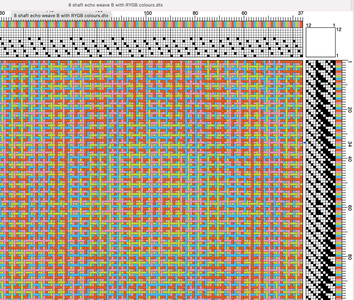|
Marian Stubenitsky’s book ‘Weaving with Echo and Iris’ is full of amazing colour and weave patterns and effects that can be achieved on 4, 8 or 16 shaft looms. They are all based on the concept of ‘network drafting’ which is something I hadn’t tried until recently. Although I found it relatively straightforward to understand the principles, I found it much harder to apply it in practice. However, I decided to do a ‘practice piece’ by simply copying one of Marion’s designs exactly as it was sown in the book.
The design I chose was an 8 shaft colour and weave structure that gives an iridescent effect. (see page 43 of Marion’s book). I also followed her detailed guidance on the choice of colours which is apparently critical to ensuring the optical mixing would give the desired effect. The technique also requires ‘parallel threading’ which doesn’t seem to be possible using Fiberworks (I think Weavit can do that but I haven’t tried it). So instead I painstakingly copied the threading draft that Marion provided into Fiberworks, and then copied across the liftplan for the design I wanted (fig. 46a). I wound the Tencel warp with 4 threads (one of each colour Red, Pink, Green, Blue) at a time, which was easier than it sounds, thanks to watching videos posted on the web). Then it was time to weave! At first, I couldn’t see the pattern hidden in the intersections of the 4 colours, but once I’d woven one repeat of 120 picks and stood back from the loom the patterns were revealed and I could definitely see the iridescence. It’s quite stunning and impressive that it works. Pretty amazing too that Marian has worked this out as it’s a really technical achievement. For now I am satisfied that I have tried it, but I must admit that I don’t really love it, so perhaps that will be my only venture into the world of Echo weaves, who knows?
2 Comments
Although I originally trained as a woven fabric designer I had taken a 33 year break from weaving to do a very different career. Before I retired I’d made up my mind to return to weaving, and I was having dreams in which I was making a warp, winding it onto a beam and threading the shafts but in reality I could only half remember how to do those things. I knew that I would need some help to get going again, but where to begin? So I booked onto a weekend course with the textile artist and designer, Margo Selby, who runs an established business making beautiful complex patterned fabrics and rugs in jewel-like colours. Somehow Margo also finds time to run courses for new and experienced weavers, so one weekend in 2019 seven of us gathered at the Yorkshire Sculpture Park in West Yorkshire and spent two fantastic days playing on 8 shaft looms which had already been set up to demonstrate a number of different weave structures. Margo was on hand to answer questions, suggest ways to explore different methods and yarns and offer encouragement. She brought along two huge portfolios of some of her fabric samples and drafts. I got a huge boost from this, and although it was 8 months before I got my new loom set up, my first sample warp was from Margo’s handout from the course. She was an inspiration and I am hugely grateful for her generosity in sharing her skills with me.
Until recently, using a profile draft to design woven patterns was new to me. It took a bit of research to understand how to do it, in my case using Fiberworks weaving software, but once I had created my profile draft, how could I turn that into a liftplan I could use when weaving?
I couldn’t find the answer by Googling, so I emailed the very helpful Bob at Fiberworks, who pinged back a reply almost instantly. The answer was to be found in the Tools menu of Fiberworks – a function called ‘block substitution’. Once I had created a profile that I was happy with, I used block substitution to covert the profile to a liftplan using the structure I required, in this case double weave. There is a menu of different weave structures including twills, summer and winter, lace, damasks, tied weaves etc., but you can also add your own presets (which I’ve yet to try). There’s the option to create either a liftplan or a normal or skeleton tie-up. Once selected a preview opens up of the resulting liftplan, fully drafted which you can modify, change or save. Using this technique has been a revelation for me, and has saved me hours of drafting time because the scarf I was weaving had 2,020 picks and no repeating patterns. To make this manageable I divided the profile into 4 sections (A,B,C,D) and created 4 separate liftplans. |
Occasional articles on the theme of weaving
ArchivesCategories
All
|






 RSS Feed
RSS Feed